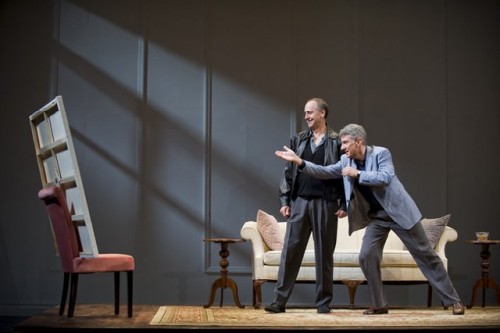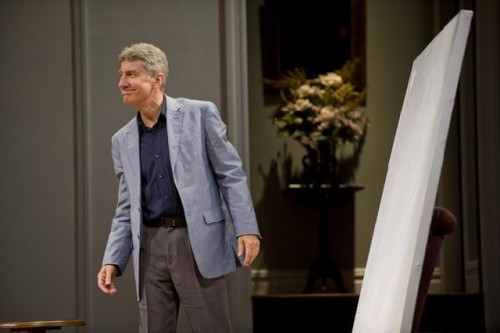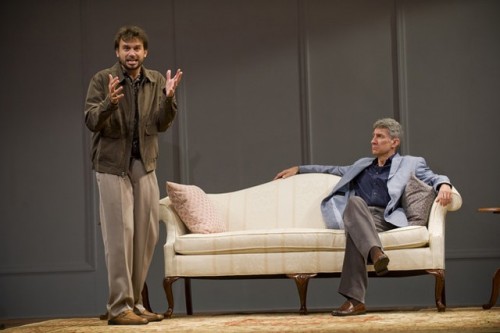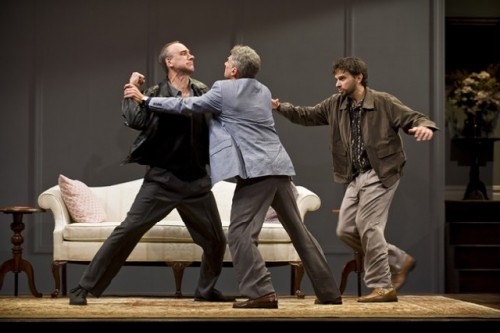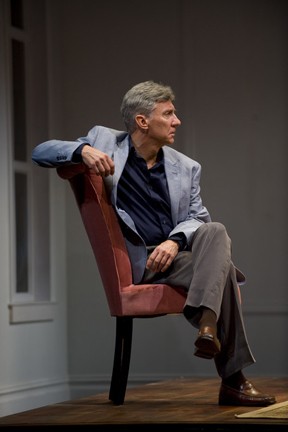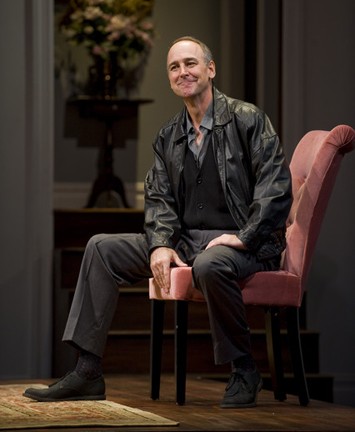Yasmina Reza’s Art
Zesty Production at Barrington Stage Company
By: Charles Giuliano - Jul 26, 2010
Art
By Yasmina Reza
Translation by Christopher Hampton
Directed by Henry Wishcamper
Scenic Designer, Robin Vest; Costume Designer, Janny Mannis; Lighting Designer, Matthew Richards; Original Music and Sound Design, Bart Fasbender; Director of Production, Tristan Wilson; Fight Choreographger, Michael Burnet; Press Director, Charlie Siedenburg; Production Stage Manager, Wesley Apfel; Casting, Pat McCorkle, CSA.
Cast: Brian Svers (Yvan), Michael Countryman (Marc), David Garrison (Serge).
Barrington Stage Company
Pittsfield, Mass.
July 22 to August 7
The one act play Art by Yasmina Reza is a phenomenon. Since its premiere in Paris, in 1995, it has been translated into 30 languages and performed all over the world. On Broadway it won the Tony Award for Best Play in 1998. She also won for God of Carnage in 2009. Her other plays to date include The Unexpected and Live (x) 3.
We first saw Art in London and more recently a staged reading at the Clark Art Institute, this winter, in collaboration with Williamstown Theatre Festival. Last night we saw a crisp and evocative production at Barrington Stage Company directed by Henry Wishcamper.
The play focuses on three friends and their reactions to the purchase by Serge (David Garrison) of what appears to be a white on white painting, he insists that it is not, by a much acclaimed artist, Antrios. His friend Marc (Michael Countryman) is outraged that Serge has purchased this “shit” for the preposterous sum of 200,000 Francs. While Yvan (Brian Svers), portrayed as a spineless straw in the wind, initially goes along with Serge but then wavers under ridicule from Marc.
The play alleges to be about aesthetics but it is actually focused on the fragile bonds of friendship.
After three different performances I tend to be less interested in the arguments about reductive abstract art. Increasingly Art strikes me as a constricting, monolithic play with characters that are shallow and annoying.
Particularly in this production in which the three men are presented as essentially one dimensional. The director, Henry Wishcamper, has moved the play at a fast pace that escalates and peaks with the fight scene. Serge and Marc take the gloves off, literally, in their ever more testy disagreement. In the mixup Yvan gets boxed in the ear. Given the rapid escalation and upper register conflict the play gets too hot not to cool down. Settling into a decline that feels more like an anticlimax.
Which is not what I felt in the more richly nuanced staged reading at the Clark with Campbell Scott in the pivotal role of Serge. Garrison’s Serge was too black and white where, like the painting he purchased and defended, we needed more variations on gray. With hints of red and a finish of cinnamon.
This is, after all, a French play for whom taste and flavors are everything. It is not about the meat of the play, an argument over a modernist painting, but all in the accompanying sauce and garnishes of the differences and petulance of relationships.
There was much that I could feeling in the conflicts of these friends that reflect those of my own life. It recalled times when I have held or espoused aesthetic opinions that have been rudely assailed by a friend. These exchanges are the more hurtful for their insulting inflexibility. My friend insists on being right, no matter what is argued. Even when the debate is on my home turf.
Of course this friend insists that it is all in fun. A kind of challenge and sport. A game in which we are not to take the issues personally. Under such pressures I feel like Yvan wanting to bob and weave my way out of adversity. For the sake of winning an argument why ruin yet another dinner party.
Have you ever had an evening in which you went to great lengths to make a wonderful dinner, pouring the best wine, only to be utterly sabotaged by guests? Or, have you turned the tables? How much I love that mantra from Who’s Afraid of Virginia Woolf about “Get the guests.” Haven't we all had those devastating evenings?
Unfortunately, Reza, for all of her talent, is no Albee. In some aspects Art is a dumbed down version of Who’s Afraid of Virginia Wolf. With the action reduced from warring couples to three male friends at each other’s throats. But with none of the haunting back story about that allegedly dead baby.
These three guys are actually quite shallow. Shall we say French? For them it’s all about fashion and style. Serge is a poseur. A pretender to culture and ersatz aesthete with a check book. He can buy into the avant-garde by simply paying for it. But his frustration surfaces when he can't buy off the support of his vulgarian friend who cares not a fig about high culture. Then there is the unpretentious Yvan, a salesman, the male equivalent of a midinette with no taste or pretensions.
Actually most of the fun in the Barrington production came from Svers and his comic rendering of the pathetic twit Yvan. We really feel for this tormented everyman who assails us with the idiotic details of plans for a totally screwed up wedding to a woman he clearly has no business to marry. Marc accuses of him of taking up their time and for being self absorbed. Yvan just wants to make nice and go out to dinner with his friends.
In promoting Art Barrington is playing on the fine arts associations. There is a sidebar White on White exhibition at Storefront Artists Project through July 27. Mass Moca Director, Joe Thompson, is speaking at Ferrin Gallery on July 27. On August 4, at 2 PM there will be a staged reading at Mass MoCA in the Sol LeWitt installation. What a perfect setting to see this play for free. That may indeed bring out some hints of apricot.
More than a century after Malevich’s seminal white on white paintings it is just so tedious and bourgeois to be debating the merits of abstract art. It is a subject that has been argued and resolved decades ago. Resurrected by these superannuated, self absorbed Parisians to the limits of patience.
The plot happens to focus on art but it might just as well have been about quantum mechanics as for example in the brilliant play Copenhagen. It is a work of superior insight and consequence. The three characters might be arguing about anything. The interest is not in the subject but rather the argument.
Perhaps it is because I know a lot about abstraction that I am impatient with Art. On the other hand I have been totally absorbed by Copenhagen which we also first saw in London. I showed the PBS video to students on numerous occasions. Repeated viewings continued to engage me because I know nothing about advanced physics. Michael Frayn’s play intrigues me by allowing access to advanced physics in perhaps the same manner that Reza’s Art catapults the audience into issues of avant-garde art.
Arguably, the more you know about art the less you will be intrigued by Art. Of course I would have to test that theory by asking a physicist what he or she thinks of Copenhagen. Perhaps next season Barrington might stage Copenhagen. Wouldn’t that be nice.
For all the right and wrong reasons you will thoroughly enjoy Art at Barrington Stage.
In terms of production values this is a stunning and pristine staging.The lighting by Matthew Richards was brilliant and precise in isolating the action. The set by Robin Vest succinctly evokes bourgeois Parisian apartments. It is intriguing that the living quarters of the three friends are suggested just by switching out the paintings. In Serge’s flat the controversial painting is propped up on a chair. In Marc’s apartment a truly hideous and inept geometric abstraction is lowered against the back wall. In Yvan’s flat a boring landscape is hung. It recalls motel art, a view of Carcasonne in the script, which has been painted by a family member.
Like their lives the living spaces of the friends are generically the same. This difference is in the sauce. Those hits of cinnamon and apricot. Which is indeed an interesting comment on the French. They speak with such exquisite tones and accents but too often have nothing tp say. With panache.
Perhaps this production at Barrington is too American where it should be more French. Here the characters are presented without the pretentious poetry of those accents. It's like doing Moliere in English or Shakespeare in French. Indeed, just what gets lost in translation?
Like Francs to Dollars. Serge paid 200,000 Francs in 1994. Of course, today, there are no Francs. So what was the conversion at the time? Let us say it was five to one. That would mean that Serge paid about $40,000 for the painting. How many Euros would that be today? In this significant detail the play is dated. Because the outrage over what Serge paid is now conveyed in an obsolete currency. So 200,000 Francs sounds like a whole lot more than we think.
In real terms Serge paid about the equivalent of an expensive car. But in Paris, where it is impossible to park, it is better not to have a car. There is a terrific metro system and cabs. In that urban context the fact that Serge indulges in an expensive painting is not that outrageous. Would Marc have gone so over the top if Serge had bought a BMW instead of a Mercedes?
So is this Art or artifiact? Or just artifice which implies artificial. Huh?

